RMS Mauretania (1938) Archival Collection
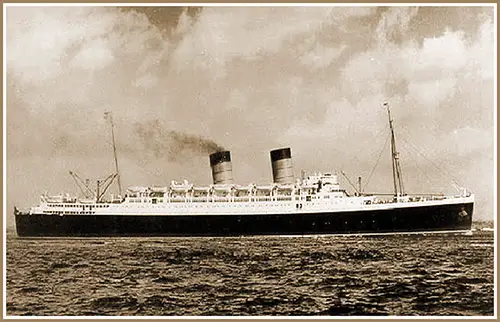
The RMS Mauretania 2 (1938) Cruising at Sea. Liners and Their Recognition, 1953. GGA Image ID # 1bbcab32ba
Mauretania 2 Quick Facts
- Flag: British
- Owner: Cunard Line, Liverpool
- Route: Southampton -- Havre -- Cobh -- New York
- Built: 1937-1939 by Cammell Laird
- Tonnage: 35,674 Gross
- Dimensions: 772 Ft. Length; 89 Ft. Width; 52 Ft. Height
- Engines: S. R. Geared Turbines, Twin Screw
- Speed: 23 Knots
- Passengers: 475 First Class, 390 Cabin Class, and 304 Tourist Class
- Funnels and Masts: Two Funnels, Two Masts
- Colors: Funnels -- Red, Black Tops, and Rings. Hull -- Black, Red Boot-Topping Below White Line
- Recognition Notes: Long low superstructure with glassed-in promenade deck. Kingposts at fore end of bridgedeck. Funnels close together, forward one close to the bridge. Bridge front stepped back, deck by deck.
- Launched: Launched on 28 July 1938, the MAURETANIA left Liverpool on her maiden voyage in July 1939. She made only two roundtrips before the British declared war against Germany, and from then until the end of 1945, she was used as a trooper carrying 350,000 men and steaming over 540,000 miles. Released in September 1946, she resumed commercial service in April 1947.
Background and History
Cunard's Second Mauretania, completed in 1939 is, at 35,674 tons, a bigger ship than her famous namesake, the first Mauretania, but is considered a medium-sized liner by present-day standards.
Few Ships had received the publicity that the Cunard-White Star showered on their new Mauretania when she came out in 1939. Heiress of the most illustrious name in steamship history, few ships have needed such severe publicity as the Mauretania II. She needed to be built up as an individual in her own right.
So her British owners flooded the United States with elaborate folio-sized brochures, moving pictures, and panoramic montages citing many newspapers, radio, and motion picture comments on this new vessel.
Since Britain's superliners have all been built in Northern Ireland or Scotland, Cunard was able to boast that the new Mauretania, constructed by Cammell Laird of Birkenhead, was the largest ship ever built in England, a slightly misleading statement to the uninformed.
However, she was no small ship, 36,000 gross tons, somewhat larger than her famous namesake. Intended as a backer-up of the two great Queens, The Mauretania II was by no means a record-breaker as to speed, being capable at her best of about twenty-five knots.
Christened late in July 1938, her owners proudly announced that the Mauretania would be known as the "Sunshine Ship," as she was designed to provide the greatest amount of light and air possible for her passengers. One hundred tons of paint were required to cover her hull, into which workers had driven 2,500,000 rivets. Her maiden voyage ended in New York in June 1939.
The luckiest man on the trip was a New Jersey passenger who won five ship's pools, taking in $2,305 and netting a nice profit over and above his passenger fare.
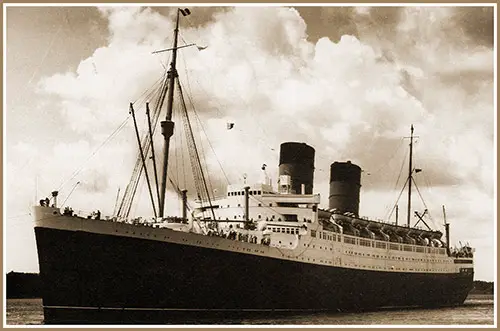
The RMS Mauretania 2 (1938) Leaves Port for the Open Sea. GGA Image ID # 1bbcc4fd93
Germany Threatens to Sink Mauretania II
The new Mauretania was one of the first liners to be armed. Two six-inch guns, three twelve-pounders, three single 40 mm. guns, twenty-two 20 mm guns, and two rocket projectors were installed by Bethlehem Steel in the United States. Before her second war-time crossing, passengers on the new British ship were warned that she would be sunk on sight by German submarines.
This threat, recalling the Germans' newspaper warning in 1915, telling travelers that it would be at their own risk if they sailed on the Lusitania, caused little commotion. However, the liner's passenger list was a mere 200.
The implication of the German warnings, that hitherto only small freighters had been sunk, was greeted with derision, particularly by those remembering the case of the liner Athenia, sent to the bottom by the Germans on the day war was declared, with the loss of over 100 passengers.
Crew members of the Mauretania realized that their ship was fair bait for the enemy and knew that her loss would be a real triumph for the Germans. However, they were reassured by their newly mounted guns and by the crew of British marines to operate them. The Mauretania, needless to say, was already painted a dull gray.
Arriving in Liverpool, after a safe voyage, the Mauretania was laid up for a time at the Gladstone Docks, where she soon began to embarrass those responsible for her security seriously. Early in November, Liver pool port authorities asked the Cunard White Star Line to move her elsewhere, and after the Captain had obtained permission from the Admiralty, she was ordered to New York.
The German threat was taken more seriously than anyone admitted from all appearances. Where There's Smoke There's Fire: Clouds of black smoke rising from the aft funnels of both the Mauretania and the Queen Mary in the spring days of March 1940 led observers along New York's waterfront to speculate that the ships' period of idleness was about to end.
These suspicions were heightened when barges swung alongside the smaller vessel and transferred piles of crates filled with wax, important in the production of munitions. A large shipment of "canned willy," as the soldiers named it, corned beef to the layman, was loaded aboard.
Members of the Mauretania's crew were seen making large purchases of flashlights, batteries, and matches along West Street to be used for emergency blackouts on the ship. These preparations were the real thing, and while the rain beat the murky gray waters of New York harbor into dark suds, the Mauretania steamed off, minus lights, bands, and waving crowds, to begin her service as a troopship.
The driving rain cut her off from sight before she had traveled many lengths beyond the Statue of Liberty. Her location was a top security secret for five years, with only occasional hints about her travels leaking out. As the months passed, she was reported to have gone through the Panama Canal, arrived in Honolulu, been seen at Bombay, and served in the Indian Ocean.
With little or no fanfare, she steamed some 538,600 miles, an almost equal distance to that of her large sister ship, the Queen Mary, which followed her out of New York the day after she had steamed off to war. The lifting of censorship requirements has revealed that she sailed for Australia by way of Balboa and Honolulu on her first voyage.
She was outfitted as a troopship, although her passenger fittings were stored in San Francisco. Once again, she was the subject of a German threat.
As she passed through the Canal, the enemy, who had been shadowing her every move, announced that she was headed into the Pacific, adding hopefully, "on a course which would take her into a concentration of U-boats off the northern coast of Galapagos Islands."
No subs were sighted, however, and they reached the "down under land" in time to join the most magnificent convoy that ever sailed, which included Britain's two "Queens," "the Grand Old Lady," and the Nieuw Amsterdam, flagship of the Dutch merchant fleet. Perhaps the most valuable fleet of liners ever to sail in company, this convoy was escorted by only one heavy and two light cruisers.
The Mauretania had only one serious accident. On January 8, 1944, she collided with the S. S. Hat Creek, a War Shipping Administration tanker, outside Ambrose Light. The crash caused serious damage to the outward-bound transport's starboard bow.
It was a critical period, and estimated that repairs would take three to six days to spread gloom in New York's Port of Embarkation offices. However, Bethlehem Steel's New York yard rose to the needs of the moment, promising to have the vessel repaired in twenty-four hours. They did even better. With plates riveted securely over the damaged area, the Mauretania sailed out of New York within twelve hours. Her troops did not disembark.
For some months, the Mauretania voyaged back and forth on seas. Her owners had never expected her to steam, carrying British, Australian, New Zealand, and Canadian troops to and from the Middle East to bolster the North African fighting front. Then she ferried Americans and Canadians to Europe and finally was put into the Pacific area.
On her longest trooping voyage, she steamed 28,662 nautical miles and went completely around the world, making it in eighty-one days, sixteen hours. On this trip, she completed the leg of about 4,000 miles from Fremantle, Australia, to Durban on the east coast of Africa in eight days, nineteen hours, breaking the previous record by nearly twenty-four hours, and averaging 21.06 knots. Her master on this voyage and many others were Captain R. B. G. Woollatt, R.D., R.N.R., of Hoylake, Cheshire, England.
In the fall of 1945, on a voyage from Bombay to the United Kingdom, the liner made still better speed, averaging 23.4 knots, although, during the six years of war, she had never been completely overhauled. Her maximum speed at one time exceeded twenty-five knots. Following this run, she was placed in the Canadian service, returning Dominion troops from the various war zones.
The Mauretania ended her trooping career on September 2, 1946, when she arrived at Liverpool for reconversion. During her seven years of war service, she had carried some 330,000 passengers and steamed nearly 600,000 miles.
Reconverted in eight months, she began her second maiden voyage to New York on April 26, 1947, having been loaded and provisioned in forty-eight hours. Cunard had allotted five days to this task, but the liner had been held up four days on her speed trials due to a furious gale.
Tourist Class Accommodations
Onboard the MAURETANIA, the roominess and quiet elegance of her Tourist Class appointments are sure to delight you. Not so large as the QUEENS but distinguished, this liner's smartly modern décor and air of genuine comfort will immediately presage you the total pleasure of an ocean voyage.
Famous for her sea-worthiness, whether on the Atlantic or in cruise service, the MAURETANIA pays complete honor to her proud heritage as the namesake of a former first lady of the seas.
Without question, yours is a genuinely pleasurable crossing when you travel Tourist Class on the MAURETANIA.
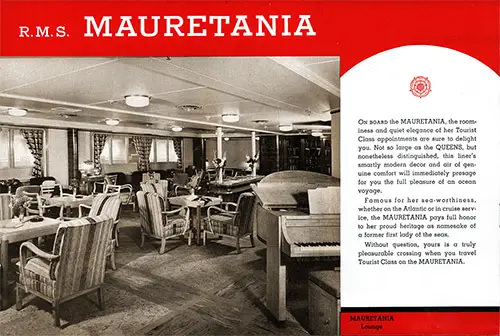
Tourist Class Lounge on the RMS Mauretania II (1938). Cunard White Star Tourist Class Brochure, January 1949. GGA Image ID # 1bbc26c535
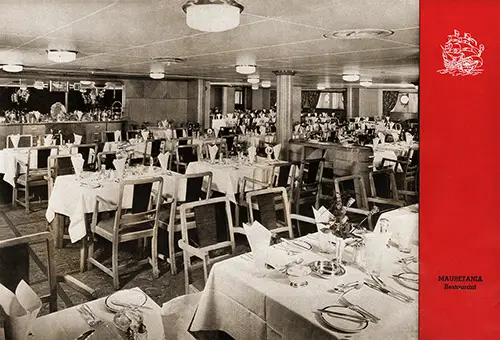
Tourist Class Restaurant on the RMS Mauretania II (1938). Cunard White Star Tourist Class Brochure, January 1949. GGA Image ID # 1bbc39e80d
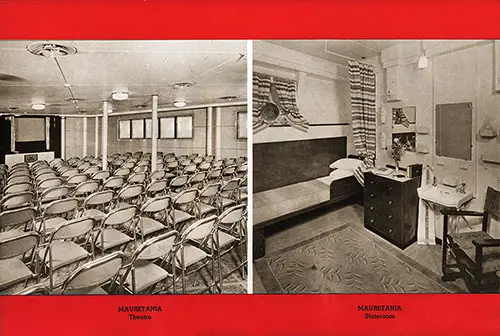
Tourist Class Theatre and Stateroom on the RMS Mauretania II (1938). Cunard White Star Tourist Class Brochure, January 1949. GGA Image ID # 1bbc79739f
RMS Mauretania II (1938) Ephemera Collection
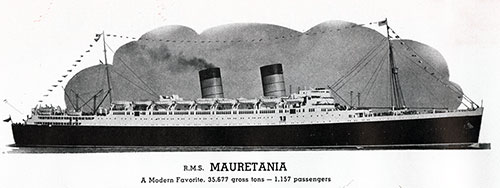
The RMS Mauretania. A Modern Favorite. 35,677 Gross Tons. 1,157 Passengers. GGA Image ID # 11f0032a9f
Mauretania (1939) Cunard Line
Built by Cammell, Laird & Co., Ltd., Birkenhead, England. Tonnage: 35,738. Dimensions: 739' x 89' (771' o.l.). Twin-screw, 22 1/2 knots. Steam turbines. Two masts and two funnels. Launched: July 28, 1938. Maiden voyage: Liverpool-New York, June 17, 1939. She made just two voyages to New York before World War II. WW2 Service: Employed as a troopship during the war. Post-War Service: Resumed trans-Atlantic service in April 1947. Passengers: 470 first, 370 cabin, 300 tourist (as of 1960). Ports: Southampton-Havre-Cobh-New York. Crew Compliment: 600 members.
Ephemera for the RMS Mauretania II (1938) available may include Passenger Lists, Menus, Brochures, Sailing Schedules, Route Maps, Photographs, and more.
Passenger Lists
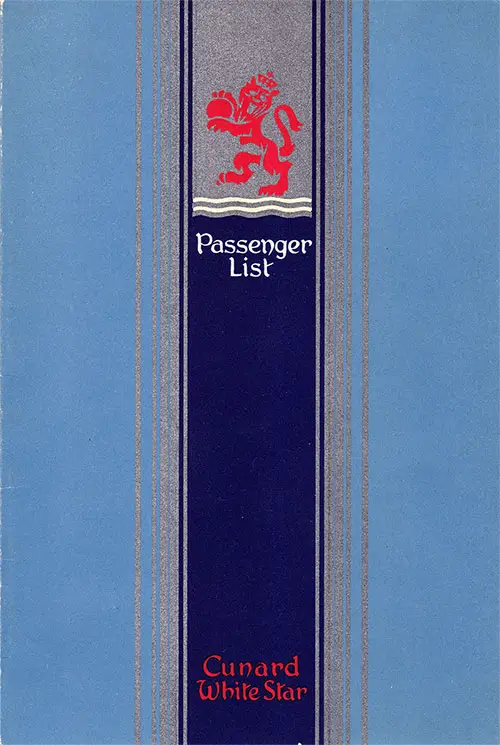
1947-10-14 RMS Mauretania Passenger List
First Class Passenger List from the RMS Mauretania of the Cunard Line, Departing 14 October 1947 from Southampton to New York Via Cherbourg, Commanded by Captain R. B. G. Woollatt, RD, RNR.

1948-09-07 RMS Mauretania Passenger List
First and Cabin Class Passenger Lists from the RMS Mauretania of the Cunard Line, Departing 7 September 1948 from Southampton to New York Via Cherbourg, Commanded by Captain R. B. G. Woollatt, RD, RNR.

1948-09-07 RMS Mauretania Passenger List
First and Cabin Class Passenger Lists from the RMS Mauretania of the Cunard Line, Sailing from Southampton for New York via Cherbourg on 7 September 1948. The Ship was Commanded by Capt.. R. B. G Woollat, RD, RNR.

1948-09-28 RMS Mauretania Passenger List
First Class Passenger List from the RMS Mauretania of the Cunard Line, Departing 28 September 1948 from Southampton to New York Via Cherbourg, Commanded by Captain R. B. G. Woollatt, RD, RNR.

1949-04-26 RMS Mauretania Passenger List
First Class Passenger List from the RMS Mauretania of the Cunard Line, Departing 26 April 1949 from Southampton to New York Via Le Havre and Cobh, Commanded by Captain R. G. Thelwell, OBE, RD, ADC, RNR.

1949-05-04 RMS Mauretania Passenger List
First Class Passenger List from the RMS Mauretania of the Cunard Line, Departing 4 May 1949 from New York to Southampton Via Cobh and Le Havre, Commanded by Captain R. G. Thelwell, OBE, RD, ADC, RNR.
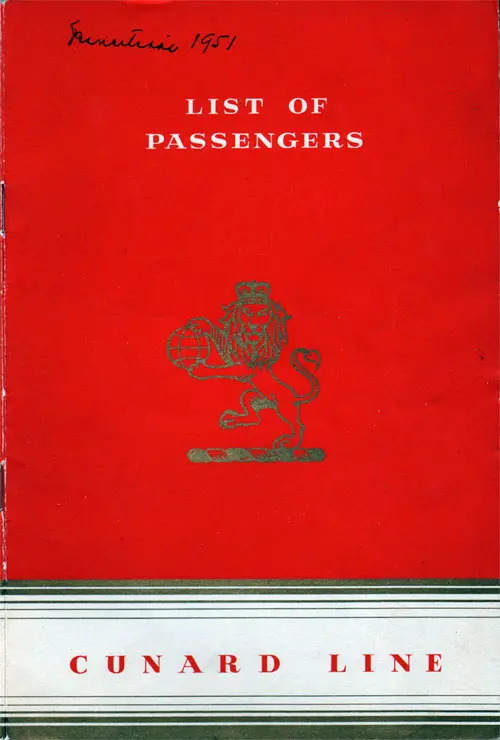
1951-11-13 RMS Mauretania Passenger Lists
First Class Passenger List for the RMS Mauretania of the Cunard Line, Departing Tuesday, 13 November 1951 from Southampton to New York via Le Havre, Commanded by Captain D. W. Sorrell.

1953-08-04 RMS Mauretania Passenger List
First Class Passenger List from the RMS Mauretania of the Cunard Line, Departing 4 August 1953 from Southampton to New York Via Le Havre and Cobh, Commanded by Captain D. W. Sorrell.

1954-05-27 RMS Mauretania Passenger List
Cabin Class Passenger List from the RMS Mauretania of the Cunard Line, Departing 27 May 1954 from New York to Southampton Via Cobh and Le Havre, Commanded by Captain A. D. Fasting, RD, RNR.

1954-07-15 RMS Mauretania Passenger List
Cabin Class Passenger List from the RMS Mauretania of the Cunard Line, Departing 15 July 1954 from Southampton to New York Via Le Havre and Cobh, Commanded by Captain R. G. Thelwell, OBE, RD, (Cdr. RNR, Rtd.).
Menus
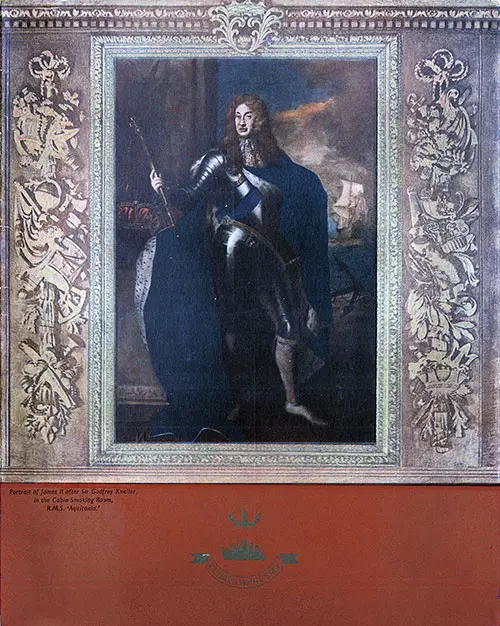
1947-10-17 RMS Mauretania Luncheon Menu
Exquisite Luncheon Bill of Fare from the Steamship RMS Mauretania of the Cunard White Star Line. Included an elegant cover with a Portrait of James II after Sir Godfrey Kneller.
Brochures
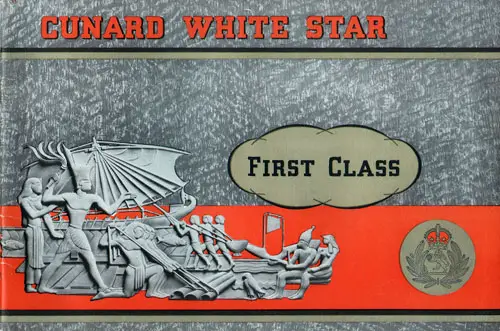
Visit Europe First Class - Cunard White Star - 1949
For Ocean Voyaging in excellent comfort, travel First Class in any of the seven Cunard White Star transatlantic luxury liners, from the resplendent Queen Elizabeth and Queen Mary, the world's largest and fastest passenger ships, to the smartly modern single-class Media and Parthia. Ships Covered in this Brochure Include the Queen Elizabeth, Queen Mary, Mauretania, Caronia, Britannic, Media and Parthia.

Cunard White Star Tourist Class on the "Big Four" - 1949
This 1949 booklet is your gangplank. Step aboard and see for yourself the spacious public rooms and tasteful cabins wherein relaxation and recreation are the rules of the day. Tourist Class on the "Big Four" of the Cunard White Star Line -- Queen Elizabeth, Queen Mary, Mauretania, and Britannic.
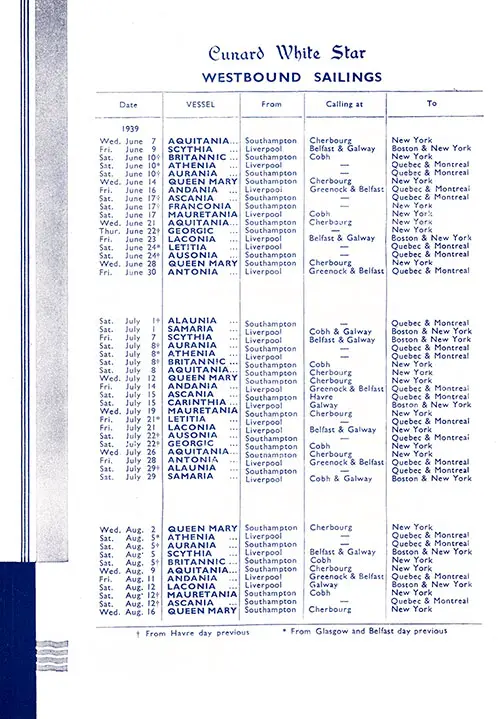
Westbound Sailing Schedule from 7 June 1939 to 16 August 1939. Ships Included the Alaunia, Andania, Antonia, Ascania, Athenia, Aquitania, Aurania, Ausonia, Britannic, Carinthia, Franconia, Georgic, Laconia, Letitia, Mauretania, Queen Mary, Samaria, and Scythia. RMS Aquitania Passenger List, 7 June 1939. GGA Image ID # 1e141a92c5
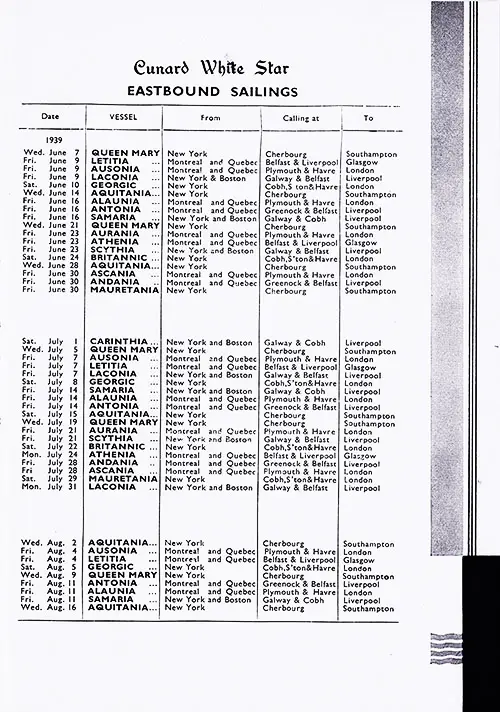
Eastbound Sailing Schedule from 7 June 1939 to 16 August 1939. Ships Included the Alaunia, Andania, Antonia, Aquitania, Ascania, Athenia, Aurania, Ausonia, Britannic, Carinthia, Georgic, Laconia, Letitia, Mauretania, Queen Mary, Samaria, and Scythia. RMS Aquitania Passenger List, 7 June 1939. GGA Image ID # 1e1424c50b
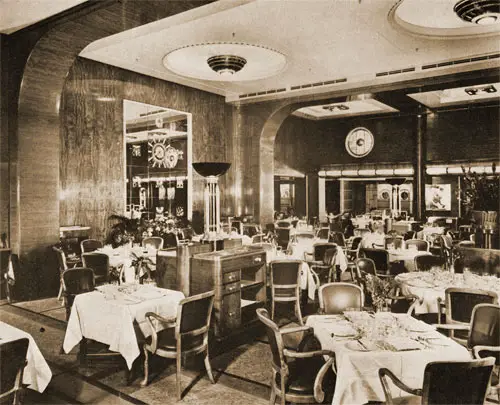
First Class Restaurant on the RMS Mauretania. First Class to Europe, 1949. GGA Image ID # 1f29bd7e12
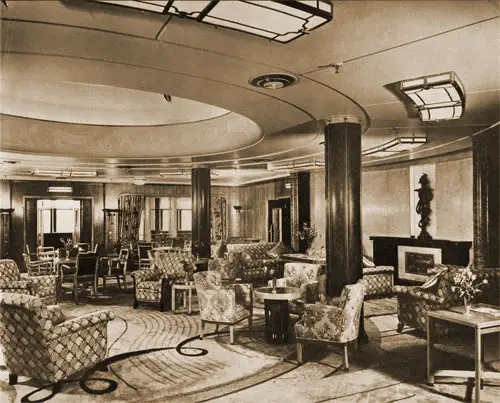
First Class Lounge on the RMS Mauretania. First Class to Europe, 1949. GGA Image ID # 1f29e24826
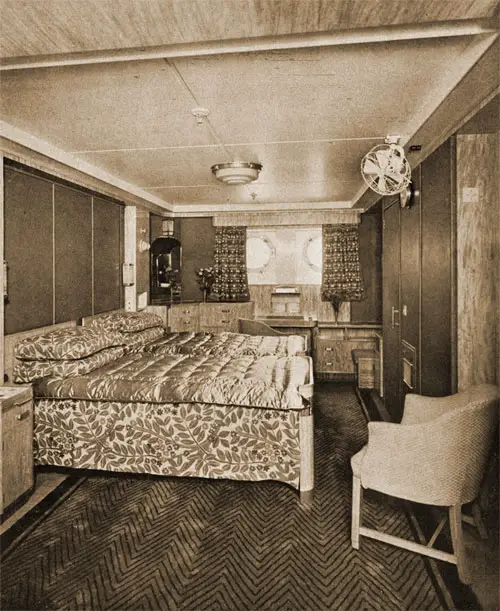
One of Many First Class Staterooms on the RMS Mauretania. First Class to Europe, 1949. GGA Image ID # 1f2a32085c
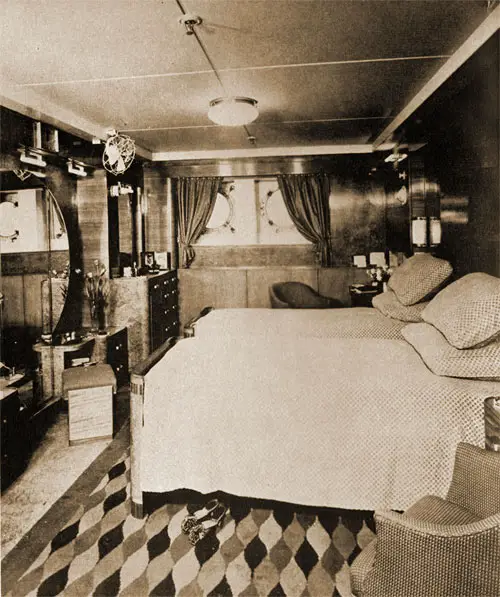
Another First Class Stateroom on the RMS Mauretania. First Class to Europe, 1949. GGA Image ID # 1f2a4d2889
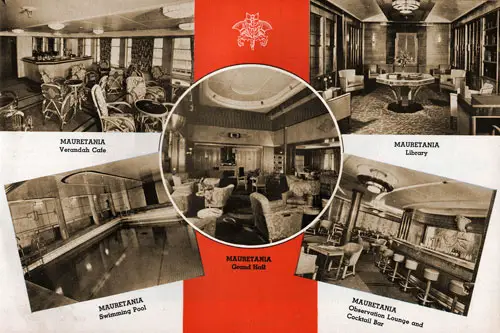
Photo Collage of First Class Public Rooms on the RMS Mauretania. Clockwise: Library, Observation Lounge and Cocktail Bar, Swimming Pool, Verandah Café and the Grand Hall in the Center. First Class to Europe, 1949. GGA Image ID # 1f2a8063cb
Bibliography
Laurence Dunn, Liners and Their Recognition, New York: John de Graff, Inc., 1953.
Cunard White Star Tourist Class on the "Big Four" - 1949.
